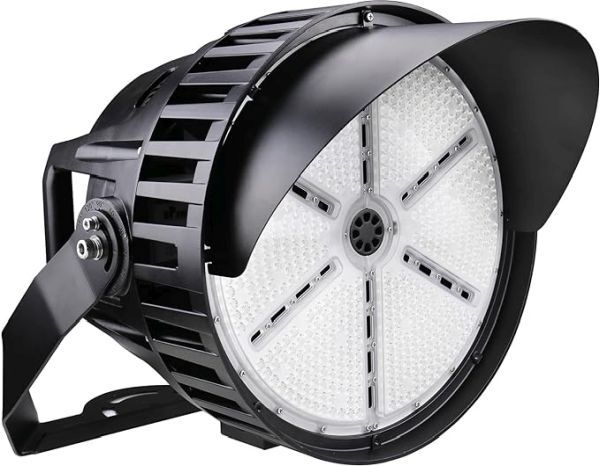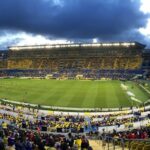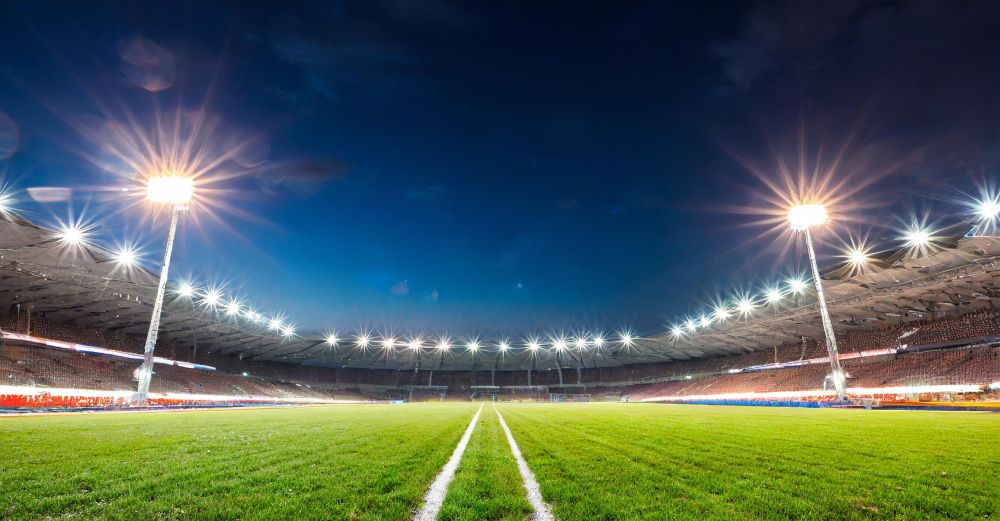500W LED soccer stadium light




Reach out to us for a complimentary lighting design consultation
Power: 500W
Lumen: 70,000lm
Luminous efficacy: 140 lm/W
Color temperature: 5000K
Beam angle: 20° / 45° / 70° / 90°
CRI: >80
Contents
About this item
Crafted to meet the exacting demands of stadiums, arenas, and outdoor settings, this formidable lighting fixture boasts exceptional specifications designed to elevate visibility and cultivate an electrifying atmosphere for both spectators and players.
Dominating Performance
With a commanding power output of 500 watts, this Stadium Light inundates your soccer field with a staggering 70,000 lumens of brightness, ensuring unparalleled visibility throughout every corner of the stadium.
Efficiency Redefined
Our Stadium Light achieves remarkable luminous efficacy, delivering an impressive 140 lumens per watt. This unmatched efficiency not only maximizes brightness but also minimizes energy consumption, offering significant cost savings over its operational lifespan.
True-to-Life Illumination
With a color temperature of 5000 Kelvin, this Stadium Light envelops your arena in a natural daylight-like glow, enriching visibility and guaranteeing true-to-life colors for an immersive viewing experience. Boasting a Color Rendering Index (CRI) of over 80, it accurately reproduces colors with precision.
Precision Beam Control
Engineered with a precisely calibrated 45-degree beam angle, this Stadium Light directs illumination precisely where it’s needed, minimizing wasteful spillage and maximizing coverage. Whether illuminating playing fields or spectator stands, it ensures uniform brightness and optimal visibility.
Built to Endure
Crafted to withstand the rigors of outdoor environments, our Stadium Light features a robust design that resists corrosion, moisture, and impact. Its sturdy housing ensures longevity, making it a dependable lighting solution for extended use.
Versatile Application
Beyond stadiums, this adaptable light is perfectly suited for a range of outdoor settings, including sports fields, parking lots, and large event venues. Wherever potent, efficient lighting is demanded, our Stadium Light delivers unmatched performance.

What is the expected lifespan of the LED stadium lights, and do they require regular maintenance or bulb replacements?
LED stadium lights have revolutionized sports lighting, offering superior efficiency, longevity, and performance compared to traditional lighting technologies.
To fully capitalize on the benefits of LED technology, proactive maintenance is essential.
Advantages of LED Stadium Lights
Long Lifespan
LED lights typically last 50,000 to 100,000 hours or more, surpassing traditional lighting systems.
Energy Efficiency: LED lights consume less energy, reducing operational costs and environmental impact.
Durability
LED lights are solid-state devices resistant to vibrations and environmental factors, ideal for outdoor stadiums.
Reduced Maintenance: Longer lifespan and durability of LED lights result in fewer bulb replacements and lower maintenance costs.
Components of Maintenance
Cleaning
Regular removal of dust, dirt, and debris prevents overheating and maintains optimal light output.
Inspection
Routine checks identify wear, damage, or malfunction, allowing for prompt resolution.
Electrical Checks: Ensuring lights operate within specified voltage ranges and securing electrical connections prevents performance issues and safety hazards.
Benefits of Proactive Maintenance
Optimized Performance
Regular maintenance ensures consistent light output and prevents premature failure.
Energy Efficiency
Clean fixtures and secure electrical connections maximize light distribution and minimize wasted energy.
Cost Savings
Reduced maintenance and lower energy consumption result in long-term cost savings for stadium operators.
What are the lighting requirements for my soccer field?
The lighting requirements for a soccer field can vary depending on factors such as the level of play, the size of the field, and local regulations. However, there are some general guidelines and standards.
Illuminance Levels
The illuminance level, measured in lux, refers to the amount of light reaching a surface. For soccer fields, the recommended illuminance levels typically range from 75 to 500 lux, depending on the level of play. Higher illuminance levels are usually required for professional or televised matches compared to amateur or recreational games.
Uniformity
It’s important to ensure uniformity in lighting across the entire field to minimize shadows and glare, which can affect players’ visibility and performance. Ideally, the uniformity ratio should be around 0.7 or higher, meaning that the minimum illuminance level is at least 70% of the average illuminance level across the field.
Color Rendering
Good color rendering is essential for players to distinguish between different objects on the field accurately. Lighting with a high Color Rendering Index (CRI) is preferable, with a CRI of 70 or above generally recommended for outdoor sports applications.
Glare Control
Glare can be a significant issue, particularly for players and spectators. To minimize glare, consider using fixtures with proper shielding and aiming them carefully to direct light where it’s needed without causing discomfort.
Energy Efficiency
Opt for energy-efficient lighting solutions such as LED fixtures, which not only provide high-quality illumination but also help reduce energy consumption and maintenance costs over time.
Lighting Controls
Implementing lighting controls such as dimming or scheduling can further enhance energy efficiency and allow for adjustments based on different usage scenarios.
Local Regulations
Be sure to consult local regulations and standards regarding lighting requirements for outdoor sports facilities. These regulations may specify criteria such as maximum light spillage, environmental impact, and neighborhood disturbance.
Professional Assessment
For larger projects or facilities requiring specialized lighting, consider consulting with lighting professionals or engineers who can assess your specific needs and recommend appropriate solutions.
What is involved in the installation process of the LED lights?
The installation process for LED lights can vary depending on factors such as the type of fixture, the location, and whether it’s a new installation or a retrofit. However, here’s a general outline of the steps involved in installing LED lights.
Preparation
Before beginning the installation process, gather all the necessary tools and materials, including the LED lights, appropriate fixtures, wiring, connectors, and any additional accessories required.
Safety Check
Ensure that the power to the area where the LED lights will be installed is turned off at the circuit breaker to prevent electrical accidents.
Remove Existing Fixtures
If replacing existing lights with LED lights, carefully remove the old fixtures, disconnecting them from the electrical wiring. Dispose of old fixtures properly according to local regulations.
Mounting
Depending on the type of LED fixture, mount the fixture securely to the desired location using screws, brackets, or other mounting hardware. Make sure the mounting surface is stable and can support the weight of the fixture.
Wiring
Connect the wiring from the LED fixture to the electrical wiring in the building. Follow the manufacturer’s instructions and local electrical codes for proper wiring connections. Use wire connectors or terminal blocks to secure the connections and ensure they are insulated properly.
Testing
After wiring the LED lights, turn the power back on at the circuit breaker and test the lights to ensure they are functioning correctly. Check for any flickering, dimming, or other issues that may indicate a wiring problem.
Adjustment and Alignment
If necessary, adjust the position or angle of the LED lights to achieve the desired lighting effect. Some fixtures may have adjustable heads or lenses that allow for precise aiming of the light.
Cleanup
Once the installation is complete and the lights are tested and adjusted, tidy up the work area by removing any debris or leftover materials.
Documentation
Keep records of the LED light installation, including the manufacturer’s specifications, warranty information, and any maintenance instructions for future reference.
Final Inspection
Conduct a final inspection of the installed LED lights to ensure they meet safety and performance standards. Make any necessary adjustments or corrections as needed.
To take the next step in consulting or making a purchase, simply enter your information on the left.
